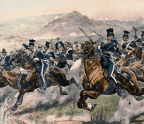

By the mid-14th century European soldiers were confronting strange and fearsome weapons that bellowed like thunder and belched smoke and flame. Such diabolical devices heralded the arrival of gunpowder technology on the Continent some five centuries after its development in China. Medieval commanders seeking to incorporate such weapons into their armies soon discovered it was no simple task. Given technological constraints of the period, bringing gunpowder weapons to bear on the battlefield proved far more difficult than employing them in a siege. Before the new weapons could yield results in the field, commanders had to either develop innovative tactics or adjust existing ones. The successful ones ultimately employed gunpowder weapons as part of a combined-arms approach to both inflict casualties and sap morale.

made use of a wider variety of tactical systems than is generally recognized. Two major trends greatly affected the tactical introduction of gunpowder weapons. The first was the rise of the professional soldier. Often described as mercenaries, these men came from the lesser noble or non-noble classes. They typically served within their own countries rather than traveling abroad to find employment. As such they were mercenaries only in the sense that they, unlike feudal levies or militia, fought for pay and were full-time soldiers. Commanders generally considered them more trustworthy and disciplined than feudal or militia levies, and they often possessed highly prized technical skills. Since they served for pay rather than for fixed periods of time, they were willing to stay in the field longer.




